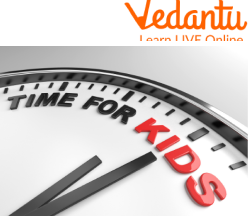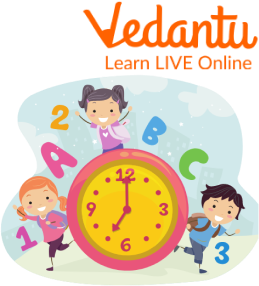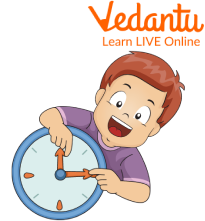




How Time Helps Us Plan Our Day and Understand the World
Have you ever wondered how people from all over the world are collectively living and functioning so systematically? How do they keep track of everything they need to do and for how long? Who is doing all this decision-making? Is it a man-made creation or a natural one? If yes, then this is the right Time for you to find out!
In this topic, you will learn about the concept of time, units of time, time zones, and the historic perspective of time.
By the end of the module, you will be able to understand the importance and application of time in everyday life and its origin.
Let’s not waste any more of your time and quickly jump onto the first topic.

Time for kids
A Brief Introduction - Time for Children
Time is a very crucial asset that helps us to measure or estimate the duration of completing a certain task or gives us a tentative idea of how long it will take to finish it. Time is also used to narrate how long ago events happened in the past. Similarly, with the help of time, we can also determine the possibility of events happening in the near future.
Time ensures the functioning and division of things much smoother and easier. It is single-handedly governing and controlling the entire world at once in different parts of the world.

An Animated Picture from 'What is Time for Kids'
Units of Time for Children and Time Zones
Why is it important to have different units of time? It is extremely important to have units of time as it would make observations and measurements more accurate and reliable. The division of time is into days, hours, minutes, and seconds. In one full day and night, there are 24 hours.
The division of hours is done in minutes and seconds. In an hour, there are 60 mins and in a minute, there are 60 seconds. Long periods of time are measured in years. There are 365 days in a year and 366 days in a leap year. A year is divided into 12 months. There are 28 to 31 days in a month.

Clock
A specific fragment of Earth encounters sunlight and the remaining part experiences nighttime. Globe is divided into 24 segments known as time zones. Time zones are split up by imaginary lines. These lines join the 2 poles together, the north and the south pole. The primary time zone commences at 0° longitude.
Historical Aspect - Time
In older times, people used to predict and measure time just by looking at the sky. They observed The Sun (sunrise, sunset), The Moon, stars, and planets interchange and switch their position. In addition to that, they also observed that days get shorter and nights longer, and later on experience various seasons.
Summary
We learned about a very important concept - Time. Time is a unit of measurement which is extremely substantial in today’s world. Time is divided into various units - days, months, mins, and hours. Ancient people invented clocks and tried to estimate time by looking at the sky before the invention of the clock. In ancient times Egyptians created calendars for tracking the days as they were passing by. They also invented a type of clock known as the sundial. The clock then later on evolved and developed into a modified and qualified instrument.
FAQs on What Is Time? Explained Simply for Kids
1. What is time, explained in a simple way for a child?
Time is the way we understand the order in which things happen. It helps us know what comes first, next, and last. Think of it as a straight line with a past (what already happened, like eating breakfast), a present (what is happening right now), and a future (what is going to happen, like playing in the evening).
2. How do we measure time using different units?
We measure time using specific units to understand how long things take. The basic units are:
- Seconds: Very short, like the time it takes to clap your hands.
- Minutes: Made of 60 seconds. A cartoon show might be 20-30 minutes long.
- Hours: Made of 60 minutes. You spend a few hours at school every day.
We use tools like clocks to measure these units and calendars to track longer periods like days, weeks, and months.
3. How can I easily tell time on a clock with hands?
Telling time on a clock with hands (an analog clock) is easy if you remember this:
- The short hand is the hour hand. It points to the hour.
- The long hand is the minute hand. It moves faster and shows the minutes past the hour.
- When the long hand points to the 12, it is the start of a new hour (o'clock).
For example, if the short hand is on the 9 and the long hand is on the 12, the time is exactly 9 o'clock.
4. What is the difference between a day, a week, and a month?
These are all ways to measure longer periods of time:
- A Day has 24 hours. It includes both daytime (when the sun is out) and nighttime (when the moon is out).
- A Week has 7 days (like Sunday, Monday, Tuesday, etc.).
- A Month usually has about 30 or 31 days, or 4 weeks. We see months on a calendar, like January, February, and March.
5. Why is it important to understand and follow time?
Understanding time is very important because it helps us organise our lives. It tells you when it's time to wake up, go to school, eat lunch, play, and go to bed. Following a schedule helps make your day smooth and ensures you don't miss out on important activities or get enough rest.
6. How did people tell time before clocks were invented?
Long ago, before modern clocks, people used nature to tell time. One of the first devices was a sundial. A sundial has a pointer that creates a shadow from the sun. As the sun moves across the sky during the day, the shadow moves around the dial, pointing to different marks that stood for the hours of the day.
7. Can time move backwards?
No, time only moves in one direction: forward. We can remember the past and plan for the future, but we can't go back to yesterday. Time is like a river that always flows downstream, from the past, through the present, and into the future, without stopping or reversing.
8. What are some real-world examples that show time is passing?
You can see time passing all around you! Some great examples include:
- A plant growing from a small seed into a big flower.
- The sun rising in the morning and setting in the evening.
- Your own body growing taller and older with each birthday.
- An ice cube melting into water when left outside the freezer.















